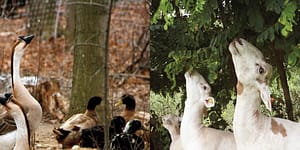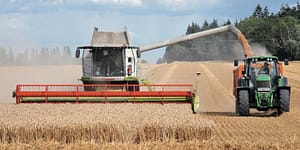Sightings While Cycling: A Journey Through Nature

During a time when many of us faced the prospect of little work or human contact, renowned naturalist Nick Acheson found a sense of peace and purpose in his pursuit of the wild geese that filled the Norfolk skies on their seasonal visits from Iceland and Siberia. With an interest in protecting the future of geese, Nick kept a diary of his sightings and the stories he discovered along the way. In the passage below, he recounts his experience while passing a cycling milestone in the beginning of February – about halfway through his journey.
The following is an excerpt from the The Meaning of Geese by Nick Acheson. It has been adapted for the web.
Greylag geese spread out to their breeding sites across North Norfolk, while remaining pinkfeet retreat to coastal grazing marshes. I pass a cycling milestone: a thousand miles cycled after geese, the distance flown by a pinkfoot from the highlands of Iceland to Norfolk. Barnacle geese gather at Holkham Lake prior to breeding.
Monday, February 1st: An Unexpected Companion
I saw not geese today, but a hare. It was crouched at the edge of a field, at the seam where a wildlife headland met a crop of oilseed rape. I had inched my bike along almost two miles of a nowhere lane – thick with mud from harvested sugar beet – until I found the same metre of hedgerow in a photo that a friend had sent.

I stopped at an ugly right-angled branch, hacked by a clumsy flail. Putting my hand in my pocket to check it against the grainy photo on my phone, I saw the hare. A negligible fraction of our Norfolk hares lack all tawny pigment in their fur. Where a typical hare is tan, these precious animals are white; though grizzled flecks still mark their coats, rendering them silver. Beside me, eleven years since I saw one last, was a silver hare.
I had heard about this exquisite animal by chance. My friend knew nothing of our silver hares and sent his photo asking what it was. It had made his day, he said. Among North Norfolk gamekeepers and farmers, silver hares must always have been known; but these lovely things are almost mythically rare. Few photographs exist; few naturalists can claim to have seen one.
The silver hare lay folded in its form, moon-beautiful, its long ears flat along its back. Checking branch by branch and stump by stump for the hare’s distinctive spot, my red bike and I had trespassed close, with just the winter-naked hedge between us. The hare was still for long enough for me to crouch and raise binoculars and wish, for once, I owned a camera; but then it calmly loped along the headland and turned onto a tyre track across the field. Here it sat, stretched up, and let me watch. No other, lesser, hare was near.
Once it had gone, into the lost ground beyond the brow, I started home, a great smile across my face. Nature, I know, is heartless, driven only by the sibling needs to prosper and to reproduce. This hare, though – this silver hare, which let me see it – was nothing less than blessing.
Thursday, February 4th: Spring Has Spoken
As days grow longer, use of the landscape by our two most numerous grey geese is changing fast. Almost the first birds I saw at home this morning were four greylags, flying upriver. Throughout the day I encountered greylags everywhere I went. They may be weeks from laying eggs, but they are leaving winter flocks and spreading across North Norfolk now, reclaiming sites in which they mean to breed.
Pinkfeet, by contrast, have contracted to the coast. In James McCallum’s first book, Wild Goose Winter, he charts three phases of their Norfolk sojourn. In the first they feed in coastal grazing marshes and nearby summer stubbles. As soon as sugar beet is lifted, they start to feed in harvested fields. More recently, this has included maize fields too. Towards winter’s end, as thousands of pinkfeet leave us, to stage in Lancashire, prior to flying on to Iceland, those which remain withdraw to coastal marshes and feed on grass again. The pinks have largely entered this last stage now.

The new flood between Wells and Holkham was busy with waterfowl: wigeon drakes, heads molten in unwonted sun, and graphite gadwall crowding round dispassionate ducks. Above them marsh harriers displayed, buoyant on the fledgling thermals of the year; beyond, on Quarles Marsh, thousands of pinkfeet grazed.
A solemn jury of herons had gathered around the Iceni fort, a lone great egret with them, each waiting to dagger a careless field vole in the winter-yellowed grass. In front of them Holkham’s flock of Russian whitefronts grazed, their orange legs and frosted foreheads visible at great distance in the kind spring light. Last week Andy counted 300 of them on the marsh.
The usual band of Egyptian geese was by the Marsh Farm track, halfway to Whincover and Burnham Overy, and with them was a single pinkfoot. I was composing this goose’s story in my head – how it came to be alone while thousands of pinks were in the marsh beyond – when two cattle egrets strutted past the horses at the farm, in their ungainly way. I’m still shocked whenever I see cattle egrets in Norfolk – so recently have they settled here – shocked and frightened too by what it means for our warming climate, and all our other wildlife.
I had more immediate worries, though. Lowering my binoculars from the egrets I cycled on, feeling at once that my back wheel needed air. I laid my bike down in the verge to pump the tyre but – air hissing from its somehow-ruined valve – in seconds it was absolutely flat.
By the shortest route, south along the lovely valley of the Burn, I was thirteen miles from home. I began to walk, wheeling my wounded bike beside me, its rhythm sounding on the tarmac as we went: two squeaky quavers and a buzzing crotchet. Larks lit our way. A collared dove sang. Two purring rooks launched into crazy helter-skelters above my head. A common gull – weeks yet from its upland nest – burst into shrieking song.
Reaching home, after cycling fourteen miles and walking thirteen more, my legs were lumpish, my back tyre shredded, and my arms sore from hitching up the saddle to spare the metal wheel; but I was rich in birds. I’d seen two dozen bramblings in a hedge, sporting their pitch-and-amber breeding plumage; heard buzzards low above their nesting woods, and a drumming great spotted woodpecker. In spite of heavy legs, and heavy snow forecast for the next few days, spring had spoken to me, through the birds.
Recommended Reads
Turning My Farm into an Ark for Lost Species: Not a Lark or a Lizard Lived There
Recent Articles
Have you heard of silvopasture? This system of managing grazing animals is an ancient practice that integrates trees and pasture into a single system for raising livestock. These systems are managed for both forest products and forage, providing short-and long-term income sources in a mutually beneficial way for healthier animals, better soil, less pest control and mowing, and…
Read MoreOxeye daisies are one of the most important plants for pollinators including beetles, ants, and moths that use oxeye daisies as a source of pollen and nectar. Instead of thinking about removing a plant like oxeye daisy, consider how you can improve the fertility and diversity of habitat resources in your home landscape, garden, or…
Read MoreThis long-lived perennial legume is used for forage and erosion control. Kudzu is edible with many medicinal uses and other applications. Pollinators of all kinds love its prodigious lavender blooms!
Read MoreMove aside, maple! We have two new syrups to add to the table. Read on for insights on tapping, selling, and eating syrup from walnut & birch trees.
Read MoreWhy is modern wheat making us sick? That’s the question posed by author Eli Rogosa in Restoring Heritage Grains. Wheat is the most widely grown crop on our planet, yet industrial breeders have transformed this ancient staff of life into a commodity of yield and profit—witness the increase in gluten intolerance and ‘wheat belly’. Modern…
Read More







